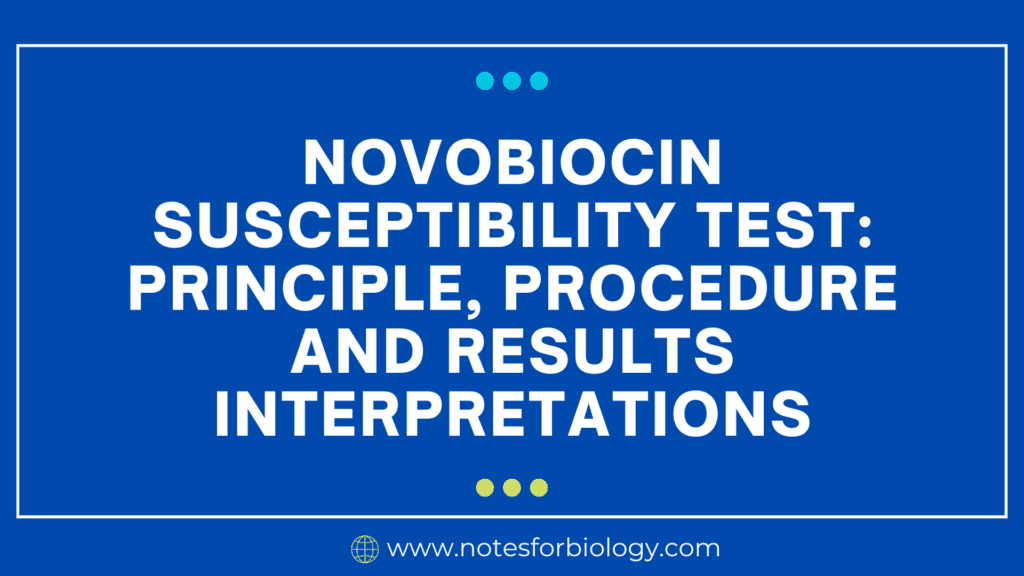Novobiocin susceptibility test is primarily used to distinguish between species of coagulase-negative staphylococci, specifically Staphylococcus saprophyticus, which is novobiocin-resistant, from other coagulase-negative staphylococci, such as Staphylococcus epidermidis, which is novobiocin-sensitive.
Table of Contents
Novobiocin susceptibility test
Novobiocin susceptibility test is a diagnostic process used in microbiology laboratories to evaluate if a bacterium is susceptible (sensitive) or resistant to the antibiotic novobiocin. This information is critical in leading clinicians to the most effective antibiotic for treating a bacterial illness.

Principle
The Novobiocin susceptibility test is based on bacterial species’ differential sensitivity to the antibiotic novobiocin. Novobiocin works by blocking DNA gyrase, an enzyme required for DNA replication. Bacteria that are vulnerable to novobiocin will exhibit reduced growth around a novobiocin disk, whereas bacteria that are resistant will grow up to the disk.
Requirements
Bacterial culture: A pure culture of the test organism.
Mueller-Hinton agar is a nutrient-rich medium used for antibiotic susceptibility testing.
Novobiocin disks are impregnated paper disks that typically contain 5 µg of the antibiotic.
Sterile swabs: Used to distribute the bacterial culture.
Inoculating loop: Used to transmit microorganisms.
Set the incubator to 35-37°C for plate incubation.
Ruler or calipers: Used to measure the zone of inhibition.
Procedure
Inoculum Preparation:
Using a sterile inoculating loop, select a colony from the test organism’s pure culture and transfer it to a tube containing sterile saline or broth.
Adjust the suspension to meet the turbidity of a 0.5 McFarland standard, which is approximately 1.5 × 10^8 CFU/mL.
Inoculation of the Agar Plate:
Dip a sterile swab into the bacterial suspension, press it against the edge of the tube to remove excess liquid, and then evenly distribute the bacteria across the whole surface of a Mueller-Hinton agar plate. This results in a uniform lawn of bacterial growth.

Applications of Novobiocin Disk:
- Using sterile forceps, insert a novobiocin disk into the center of the inoculated agar plate.
- Gently press the disk into full contact with the agar surface.
Incubation:
To avoid condensation from interfering with the results, incubate the plate at 35-37°C in an inverted position for 18-24 hours.
Measuring the Zone of Inhibition
After incubation, use a ruler or calipers to measure the diameter of the inhibitory zone surrounding the novobiocin disk.

Results Interpretation
To interpret the data, the diameter of the zone of inhibition is measured and compared to conventional criteria:
Sensitive:
If the zone of inhibition around the novobiocin disk is 16 mm or larger, the organism is deemed vulnerable to novobiocin.
For example, Staphylococcus epidermidis typically has a zone of inhibition that is larger than 16 mm.
Resistant:
If the zone of inhibition is 15 mm or less, the organism is deemed novobiocin-resistant.
For example, Staphylococcus saprophyticus often has a 12 mm or smaller zone of inhibition, showing resistance.
Quality Control
To confirm the accuracy of the Novobiocin susceptibility test, quality control strains should be examined simultaneously:
The sensitive control strain is Staphylococcus epidermidis ATCC 12228. This strain should have a zone of inhibition ≥16 mm.
The resistant control strain is Staphylococcus saprophyticus ATCC 15305. This strain should have a zone of inhibition ≤12 mm.
Clinical Relevance
The Novobiocin susceptibility test is especially useful in clinical microbiology for the following reasons:
Identification of Staphylococcus saprophyticus:
S. saprophyticus is a prevalent cause of urinary tract infections, particularly in young women. Its resistance to novobiocin distinguishes it from other coagulase-negative staphylococci, allowing for an accurate diagnosis and suitable treatment.
Antibiotic selection:
Knowing whether a staphylococcal isolate is resistant or sensitive to novobiocin can help guide antibiotic therapy, especially in cases where coagulase-negative staphylococci are involved.
Differentiation of Staphylococci
The test aids in the identification of coagulase-negative staphylococci, which is critical for epidemiological research and infection management in hospital settings.
Frequently Asked Question
What is Novobiocin susceptibility test ?
Novobiocin susceptibility test is a diagnostic process used in microbiology laboratories to evaluate if a bacterium is susceptible (sensitive) or resistant to the antibiotic novobiocin. This information is critical in leading clinicians to the most effective antibiotic for treating a bacterial illness.
Is E coli sensitive to Novobiocin?
The mechanism of action of novobiocin was investigated in several strains of Escherichia coli. Except for strain ML mutants, the medication decreased cell division and retarded cell growth in all strains tested.
What are the requirements of Novobiocin susceptibility test ?
The requirements of Novobiocin susceptibility test are
1. Bacterial culture: A pure culture of the test organism.
2. Mueller-Hinton agar is a nutrient-rich medium used for antibiotic susceptibility testing.
3. Novobiocin disks are impregnated paper disks that typically contain 5 µg of the antibiotic.
4. Sterile swabs: Used to distribute the bacterial culture.
5. Inoculating loop: Used to transmit microorganisms.
6. Set the incubator to 35-37°C for plate incubation.
7. Ruler or calipers: Used to measure the zone of inhibition.
Related Article
G-protein coupled receptor (GPCR): β -adrenergic signalling pathway




